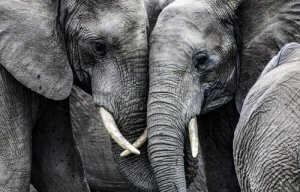Why Elephants Are Social Animals


Written and verified by the vet Érica Terrón González
Elephants are social animals, which means they spend a great deal of their time interacting with other members of their group. This is because they’re highly intelligent creatures, and are capable of developing a clearly distinguishable social structure within the herd.
The intelligence of elephants
In animal psychology, intelligence is the ability to solve problems. These problem-solving skills are often present in animals that live in varied environments, as it shows that they’ve been able to overcome threats to their survival.
The human concept of intelligence focuses more on our ability to solve complex problems, rather than evolutionary challenges. This is where the two definitions of intelligence differ: in the animal kingdom, intelligence is the ability to adapt to change.

Why are elephants considered intelligent?
We all know that elephants have a long lifespan. They travel huge distances in their lifetime and are born with highly developed central nervous systems. These are all traits that are usually associated with the ability to solve problems. Other important factors to consider are:
- Their ability to wield tools, both in the wild, and in captivity. This is associated with greater cognitive ability and the power to overcome challenges. For example, they can use their trunks to peel the bark off trees, and pick out the tastiest leaves.
- Self-awareness. Scientists have done experiments in which elephants were able to use mirrors to find hidden food.
- And finally, memory. Humans have always known that elephants have a good memory. They learn quickly, and can file away knowledge for future use.
All these aspects have to be taken into account when dealing with elephants. As intelligent beings, they’re able to find solutions to all kinds of dangerous situations.
Elephants are social animals
Family structure and learning
Female elephants live in family groups. These groups aren’t usually all that large, and are led by a matriarch, which is usually the oldest elephant in the herd.
For example, both the African savanna elephant (Loxodonta africana) and the Asian elephant (Elephas maximus) form groups of 8 – 12 individuals. The African forest elephant (Loxodonta cyclotis) forms even smaller groups, usually consisting of just one female and her young.

Within the family nucleus, young, unpaired females act as babysitters, helping baby elephants learn and develop. However, if there’s one member of the herd that has the greatest impact on learning, it’s the matriarch. As she is the oldest female, the other elephants copy her behavior, and pass these skills on to their young.
Elephants are social animals: group hierarchy
Because they tend to stay in the same group for their entire lives, elephants form very strong bonds. Within female groups, aspects such as age, size, and parentage impact the social status of each member.
Normally, the matriarch serves as the group’s memory, helping to ensure their survival.

Calves born to dominant females tend to have a greater chance of survival. This seems to be because more dominant members are given first pick when it comes to food, improving the quality of their milk.
What about male elephants?
Male elephants leave their family groups during adolescence. Normally these young males form their own groups, where they constantly battle to improve their social status.
When the males reach 18-20 years of age, they’re physically larger than the females, and become ideal mates.

At this point, males enter a state known as musth. During this period, they exhibit highly aggressive behavior, combined with increased levels of reproductive hormones. This typically occurs during the wet season.
Males in musth are dominant and more likely to mate with females. Other characteristics which influence dominance among males include size and age.
Elephants are social animals, which means they spend a great deal of their time interacting with other members of their group. This is because they’re highly intelligent creatures, and are capable of developing a clearly distinguishable social structure within the herd.
The intelligence of elephants
In animal psychology, intelligence is the ability to solve problems. These problem-solving skills are often present in animals that live in varied environments, as it shows that they’ve been able to overcome threats to their survival.
The human concept of intelligence focuses more on our ability to solve complex problems, rather than evolutionary challenges. This is where the two definitions of intelligence differ: in the animal kingdom, intelligence is the ability to adapt to change.

Why are elephants considered intelligent?
We all know that elephants have a long lifespan. They travel huge distances in their lifetime and are born with highly developed central nervous systems. These are all traits that are usually associated with the ability to solve problems. Other important factors to consider are:
- Their ability to wield tools, both in the wild, and in captivity. This is associated with greater cognitive ability and the power to overcome challenges. For example, they can use their trunks to peel the bark off trees, and pick out the tastiest leaves.
- Self-awareness. Scientists have done experiments in which elephants were able to use mirrors to find hidden food.
- And finally, memory. Humans have always known that elephants have a good memory. They learn quickly, and can file away knowledge for future use.
All these aspects have to be taken into account when dealing with elephants. As intelligent beings, they’re able to find solutions to all kinds of dangerous situations.
Elephants are social animals
Family structure and learning
Female elephants live in family groups. These groups aren’t usually all that large, and are led by a matriarch, which is usually the oldest elephant in the herd.
For example, both the African savanna elephant (Loxodonta africana) and the Asian elephant (Elephas maximus) form groups of 8 – 12 individuals. The African forest elephant (Loxodonta cyclotis) forms even smaller groups, usually consisting of just one female and her young.

Within the family nucleus, young, unpaired females act as babysitters, helping baby elephants learn and develop. However, if there’s one member of the herd that has the greatest impact on learning, it’s the matriarch. As she is the oldest female, the other elephants copy her behavior, and pass these skills on to their young.
Elephants are social animals: group hierarchy
Because they tend to stay in the same group for their entire lives, elephants form very strong bonds. Within female groups, aspects such as age, size, and parentage impact the social status of each member.
Normally, the matriarch serves as the group’s memory, helping to ensure their survival.

Calves born to dominant females tend to have a greater chance of survival. This seems to be because more dominant members are given first pick when it comes to food, improving the quality of their milk.
What about male elephants?
Male elephants leave their family groups during adolescence. Normally these young males form their own groups, where they constantly battle to improve their social status.
When the males reach 18-20 years of age, they’re physically larger than the females, and become ideal mates.

At this point, males enter a state known as musth. During this period, they exhibit highly aggressive behavior, combined with increased levels of reproductive hormones. This typically occurs during the wet season.
Males in musth are dominant and more likely to mate with females. Other characteristics which influence dominance among males include size and age.
All cited sources were thoroughly reviewed by our team to ensure their quality, reliability, currency, and validity. The bibliography of this article was considered reliable and of academic or scientific accuracy.
- Fowler M, Mikota S. Biology, Medicine, and Surgery of Elephants. Hoboken: John Wiley & Sons; 2008.
This text is provided for informational purposes only and does not replace consultation with a professional. If in doubt, consult your specialist.








